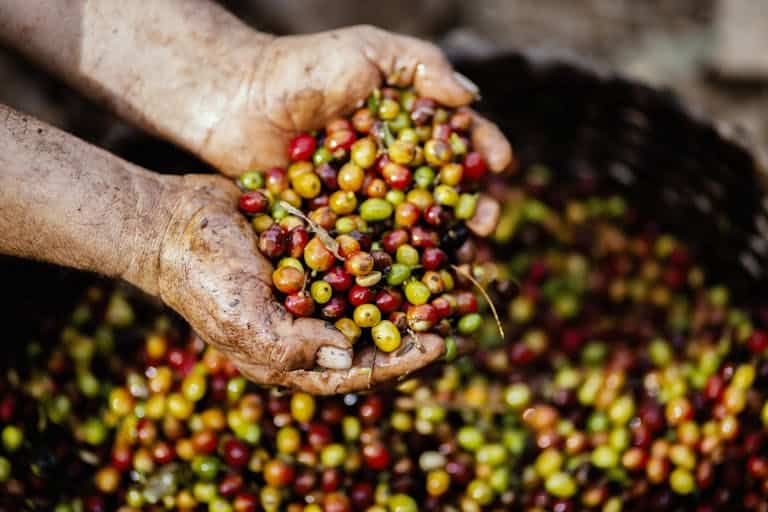Simply put, what is coffee acidity
so if you are new to the world of coffee which is fine i am as well its the reason I’m writing this at the moment i want to grow my knowledge base as well,
Coffee beans in general are slightly acidic but if you roast them they will become less acidic,
since ive been working in the kitchen for close to 5 years now drinks and coffee have not my main interest points since i started at the age of 15 or 16,, but now as an adult almost 22,
it takes a bit more interest to me, especially since it has grown such in the last few years,
so what is coffee acidity in easy terms, well the primary taste of coffee is acidic which is why you can use coffee in a lot of pastries, tiramisu or chocolate cake being quite common examples,
But when you have a high acidity in the coffee its becomes more clean brighter and a light crisp flavor and aroma,
Then if you add some cream and make that latte foam art that is so popular on TikTok or Ig reels,
then you got a product that will sell worldwide since coffee can be boring and basic
or it can be a fantastic tour, for the palette,

What is Coffee Acidity?
First things first—when we talk about coffee acidity, we don’t mean sourness or bitterness. Coffee acidity actually refers to the brightness or liveliness you taste in a cup of coffee. It’s similar to the crisp sensation you get when biting into an apple or tasting a citrus fruit. This tangy, vibrant element adds depth and complexity to the coffee.
Not all coffees have the same level of acidity, which makes tasting them so exciting. Some coffees have high acidity, giving them fruity or floral notes. Others have lower acidity, leading to a smoother, richer flavor. Neither one is “better”—it all depends on what you like.
In professional coffee tasting, known as cupping, acidity is one of the key factors used to evaluate the overall quality of the coffee.
Types of Coffee Acidity

1. Malic Acidity
Malic acidity is linked to fruits like apples and pears. If a coffee has malic acidity, you’ll likely experience a crisp, clean taste with a lingering sweetness. Imagine the refreshing bite of a green apple—that’s malic acidity at work.
2. Citric Acidity
Citric acidity is what you find in citrus fruits like lemons, limes, or oranges. It brings a sharp, zesty kick to the coffee. If you’ve ever had coffee that reminded you of lemonade or orange juice, you were likely tasting citric acidity.
3. Tartaric Acidity
Tartaric acidity is similar to the kind you find in grapes or wine, giving the coffee a more wine-like, tangy quality. Coffees with tartaric acidity often have bold, punchy flavors with deep complexity, much like red wine.
4. Phosphoric Acidity
Phosphoric acidity is known for being smoother and sweeter. It’s less sharp than citric or tartaric acidity, often adding a candy-like or sugary finish to the coffee. Coffees with phosphoric acidity tend to have a rounder, more balanced flavor, making them enjoyable for those who prefer softer acidity.
5. Acetic Acidity
Acetic acidity, while found in vinegar, can add a pleasant sharpness to coffee in small amounts. It provides a sweet, tangy complexity, similar to the flavors you’d find in balsamic vinegar. When balanced well, acetic acidity can create a dynamic and layered flavor experience.
Why Coffee Acidity Matters
So, why is acidity in coffee important? Acidity plays a big role in shaping the overall taste and character of your coffee. It adds depth, complexity, and energy to the cup. Without acidity, coffee would taste flat and dull.
Think of acidity as the element that wakes up your taste buds. It’s what gives coffee that spark, the thing that makes you say, “Wow, this is really good!” While a coffee with less acidity can still be delicious, it will likely taste more mellow and smooth. That might not be what you want if you enjoy a bright, vibrant cup.
For coffee lovers who enjoy exploring different varieties and tasting all the subtle flavors coffee has to offer, acidity is a key factor to pay attention to.
How Acidity Varies by Region
One of the most exciting things about coffee is how its acidity changes depending on where it’s grown. Factors like climate, altitude, and soil all influence a coffee’s acidity. Here’s a quick look at what you can expect from different regions:

1. African Coffees
If you enjoy bright, fruity coffees, African beans are a great choice. Coffees from countries like Ethiopia, Kenya, and Burundi are known for their strong acidity, often featuring flavors of berries, citrus, and florals. These beans usually have high levels of malic and citric acidity, which gives them a clean, vibrant taste that’s refreshing and exciting.
2. Latin American Coffees
Coffees from Latin American countries like Colombia, Costa Rica, and Guatemala typically have a balanced acidity. You’ll often find a combination of malic and phosphoric acidity, which gives these coffees a sweet, bright flavor with subtle fruitiness. These beans are popular because they offer a pleasant balance between brightness and smoothness, making them a hit with a wide range of coffee drinkers.
3. Asian and Pacific Coffees
For those who prefer a less acidic coffee, beans from regions like Sumatra, India, and Papua New Guinea are a great option. These coffees tend to have lower acidity and feature earthy, spicy, and sometimes chocolatey flavors. They also have a fuller body and provide a smoother, more mellow drinking experience. If you’re not into bright, fruity flavors, these coffees will likely suit your taste perfectly.
The Roast Factor: How Roasting Affects Acidity
Roasting has a big impact on the acidity level of your coffee. In general, the lighter the roast, the more acidity you’ll notice.
As beans roast, their natural acids begin to break down, which is why darker roasts have less acidity and focus more on body and bitterness.
Extraction of Roast Level Backed by Science
Here’s how different roast levels affect acidity:

1. Light Roast
Light roasts keep the most acidity, allowing the natural flavors of the coffee bean to really stand out. Fruity and floral notes are common in light roasts, making them popular with people who enjoy bright, complex coffees.
2. Medium Roast
Medium roasts strike a balance between acidity and body. They still have some acidity, but it’s complemented by increased sweetness and richness.
You get a mix of brightness with a smoother finish. If you like a bit of acidity but prefer it to be more rounded, medium roasts are a perfect middle ground.
3. Dark Roast
Dark roasts have much less acidity because the beans are roasted longer, which breaks down most of the natural acids.
Instead of bright flavors, you’ll taste more roasted, caramelized, or smoky notes.
These coffees are often fuller-bodied and have a heavier, richer mouthfeel. If you prefer coffee with minimal acidity, dark roasts are a great match for your taste.
How to Taste the Acidity in your own Coffee
Now that you have an understanding of coffee acidity and its different types, here’s how to spot it in your cup:

1. Pay Attention to the First Sip
Acidity is often one of the first things you’ll notice when you take a sip. Right after that first taste, you’ll feel if the coffee is bright and lively or more mellow and smooth. A bright, vibrant sensation usually signals higher acidity.
2. Compare Coffees
A great way to learn about acidity is by tasting different coffees side by side. Try a high-acidity coffee, like an Ethiopian, and compare it with a low-acidity coffee from Sumatra. This direct comparison will help you better identify the presence of acidity in your cup.
3. Focus on Fruit Flavors
Acidity often comes across as fruity or citrusy flavors. If your coffee has notes of apple, lemon, or berries, it likely has higher acidity. These flavors are key indicators of a bright, acidic cup.
4. Notice the Mouthfeel
Acidity also impacts the texture of the coffee. Coffees with high acidity tend to feel lighter and more crisp, while those with lower acidity usually have a heavier, smoother mouthfeel. Pay attention to how the coffee feels as you sip!
Frequently Asked Questions (FAQs)
1. Does high acidity mean the coffee will be sour?
No, high acidity doesn’t mean sourness. A well-balanced high-acid coffee will taste vibrant and refreshing, not sour or unpleasant.
2. Are acidic coffees bad for my stomach?
Some people with sensitive stomachs may find high-acid coffees a bit harsh. If that’s the case for you, try darker roasts or beans from regions like Sumatra, which naturally have lower acidity.
3. What’s the best brewing method for high-acidity coffees?
Pour-over methods like V60 or Chemex tend to highlight acidity more than immersion methods, like French press. If you enjoy bright, acidic coffees, these brewing methods are a great choice.
4. Can I reduce acidity by changing the brew method?
Yes! Brewing with cooler water or extending the brew time can sometimes reduce acidity. However, the coffee’s natural acidity will still come through, so don’t expect a dramatic change.
5. What’s the difference between acidity and bitterness in coffee?
Acidity is the brightness or sharpness in coffee, often a desirable quality. Bitterness, on the other hand, usually comes from over-extraction or darker roasting and is generally something to avoid.
Conclusion: Embrace the Acidity!
Coffee acidity is a wonderful aspect of your brew, and understanding it can deepen your appreciation for every cup.
Whether you love a bright, zesty coffee or prefer something more mellow and smooth, knowing how acidity works helps you make more informed choices—and may even lead you to discover new favorites.
Next time you brew a cup or visit your favorite café, focus on the acidity in your coffee. Notice how it balances with the other flavors and how it affects your overall experience.
You might just find that your ideal cup of coffee has a little extra zing!
Happy sipping, and feel free to share your acidity discoveries with me—I’d love to hear about what you’re tasting!







